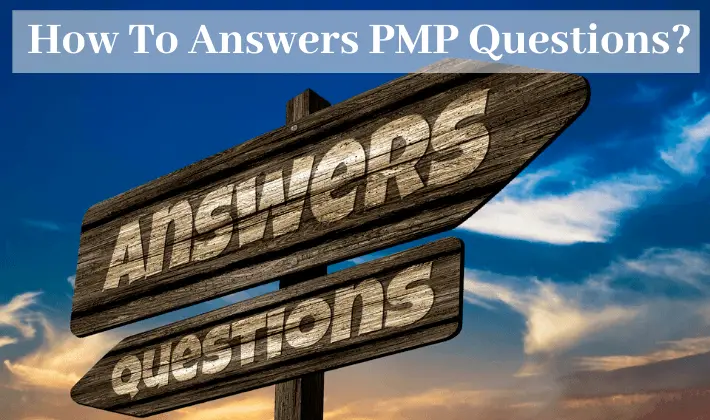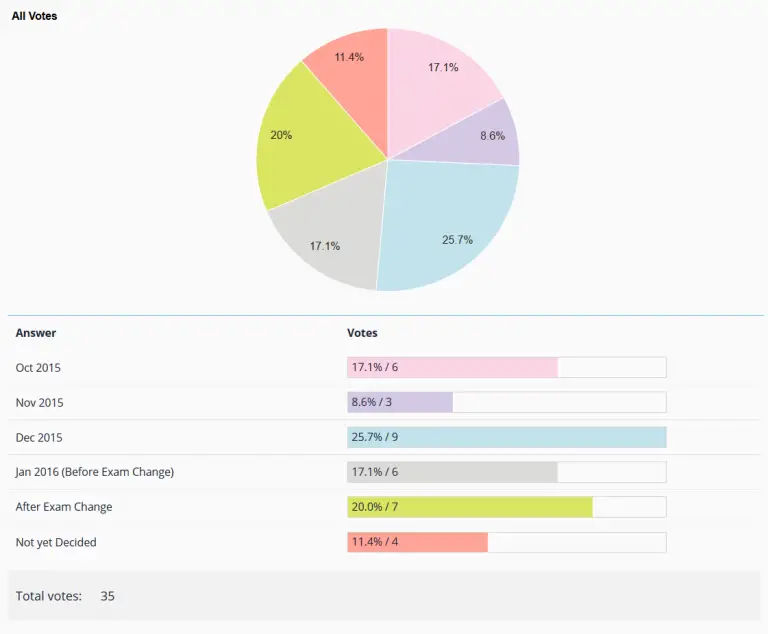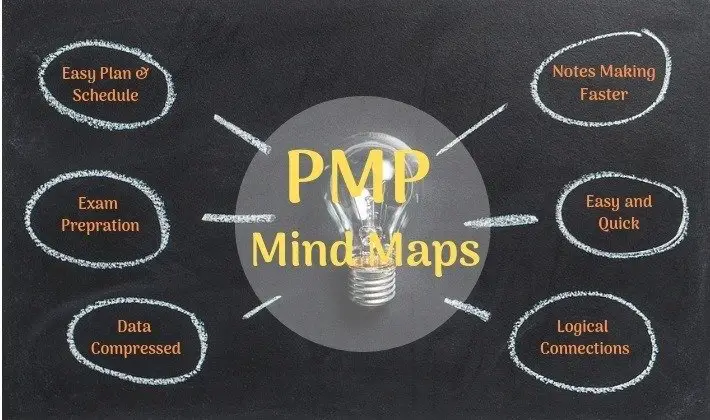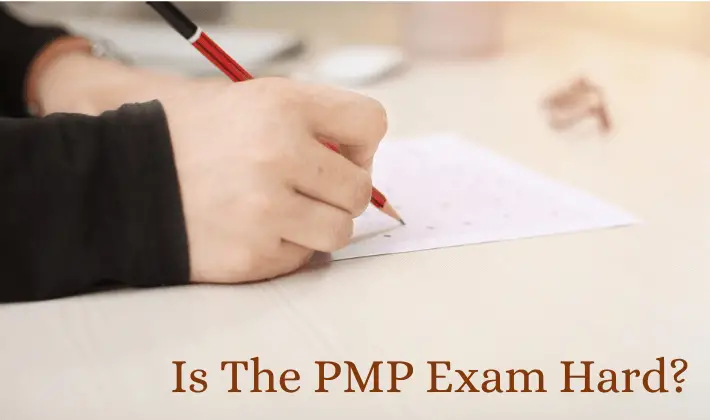You might be wondering how to answer PMP exam questions correctly to pass the certification test in your first attempt.
You can correctly answer the PMP questions by following a few logical steps. Luckily, the exam contains multiple choice questions and you have to choose from one of the four options that are given for each question. This can be easily done by applying the PMBOK Guide concepts and eliminating incorrect options.
The PMP exam has seven different type of questions. Out of these, Situational questions and Professional Responsibility (Ethical) questions are most tricky and difficult. Situational questions form the bulk of the exam.
In this post, you will find the logical steps that are needed to answer the different type of questions including Situational questions and Professional Responsibility questions. You will also find tips, tricks, techniques, and strategies that will help you in answering the PMP questions.
How to Answer the PMP Exam Certification Questions?
You can follow the below mentioned steps to tackle the PMP Exam questions:
Step I – Start by reading the question carefully
- Generally, these type of questions are very long with a lot of redundant information so you should read them patiently.
- Separate actual question from redundant sentences and/or words and identify the main part of the question.
- Understand the context of the question to determine what the question is really asking.
- Do not assume any information that is not provided in the question.
- Identify the PMBOK Guide keyword(s) in the question.
- Determine the PG (Process Group), KA (Knowledge Area), and Process(es) mentioned in the the question.
- Look for the negative keywords like NOT, EXCEPT, EXCLUDING, NEVER. Make sure you have understood what do they want to ask.
- Look for words like BEST, FIRST, INITIAL, NEXT, LAST, ALWAYS, MOST, MOST LIKELY, LESS LIKELY, MOST UNLIKELY, PRIMARY etc. Make certain how would the answer change because of these keywords.
Always remember that the key to the answer is in the question itself.
Step II – Go through the options carefully
- Sometimes the options too are very long with redundant information so you should not rush through the options.
- Read all the options completely even if an option is looking obviously incorrect in the initial glance.
- Understand the finer differences between of each option.
- Match the language and context of question with that of option.
- There may be some options that have true statements but their context is different from the question’s context. Eliminate them.
- Do not assume any information that is not provided in the option.
- Try to eliminate obvious incorrect options.
The answer is within the given options. Always remember that PMI is looking for the best answer among the given options.
Step III – Ascertain the answer
- Remember PMI-isms when answering
- Think that you are a project manager for a large project while answering.
- Think yourself as a project manager working in a matrix organization while answering the question. It means that you are sharing the authority with a functional manager.
- You might feel that the most appropriate answer to the question is not among the 4 options. So, you should choose the best answer from the options given.
- Choose the option that is the best thing or the first thing or most likely to be done in the situation given in the question.
- When there is a ‘fill in the blank’ question, it is possible that correct answer may not give grammatically correct result, when it is inserted in the blank. you should ignore such things.
- Look out for options with definitive words like ALWAYS, MUST, MANDATORY, CERTAINLY, NEVER, DEFINITELY, COMPLETELY etc. Most probably these are incorrect.
- Alternatively, option having words like LIKELY, PROBABLY, SOMETIMES, PERHAPS, OFTEN, GENERALLY etc. are likely to be the correct answer.
Always check if there is a correlation between what the question is asking and what the option is saying.
The above mentioned steps are applicable to all type of the exam questions that are detailed in the next section.
Different Types of The PMP Exam Questions
There are seven different types of questions that come in the PMP certification test. These are:
- Situational Questions
- ITTO Questions
- Definition/knowledge Based
- Mathematical/Formula Based
- Diagram Based
- Data Interpretation
- Professional Responsibility Questions
The steps and guidelines mentioned in the previous section are useful for all seven types of questions but each type has some more idiosyncrasies. Let’s consider each type one by one.
1. How to Answer Situational Questions?
These are based on the Project Management (PM) concepts as explained in the PMBOK Guide. They require application of the PM concepts and interpersonal skills like conflict management to practical scenarios.
In order to correctly answer Situational questions, you have to understand the situation and apply the appropriate PM concept.
Usually, these questions are very tough and are difficult to score. They not only test your knowledge but also application of that knowledge to real life situations.
You need to have a sound understanding of the PM concepts for answering the Situational questions.
2. How to Answer ITTO Questions?
PMP ITTO (Inputs, Tools & Techniques, and Outputs) questions are direct questions based on the processes listed in the PMBOK Guide. These are lot less tricky and just require a thorough understanding of the PMBOK Guide processes.
In order to correctly answer ITTO questions, you do not need to remember each and every ITTO, but you need to have a good understanding of each process and its constituents. In fact, you can score 100% marks for these type of questions, if you have a thorough understanding of the ITTO.
You can download my free PMP ITTO Chart to learn about each process and its constituents. By downloading it, you will also get a companion workbook to practice ITTO.
To get a deeper understanding and knowledge of the ITTO, you can look at the following ITTO learning tools:
- Dynamic PMP ITTO Excel Spreadsheet to quickly discover how and where an ITTO term is used in the PMBOK Guide.
- PMP Process Mind Maps to pictorially learn about a complete process in a single page view.
- PMP ITTO Practice Questions Quiz for validating your ITTO knowledge.
These tools are useful for both PMP and CAPM aspirants. If you want, you can buy these tools by investing a small amount.
You can also buy these tools as a bundle at 10% discount.
In addition to the general steps that are mentioned in the first section, you need understand the following to correctly answer the ITTO questions:
- Purpose and significance of all the PMBOK Guide processes.
- Relationships between different processes.
- Major Inputs, Tools & Techniques, and Outputs of each process.
You should note that the PMP exam is not meant to test your memory. You will be good to go if you understand the significance of major ITTO.
3. How to Answer Definition/Knowledge Based Questions?
These questions are similar to ITTO questions. They too are directly based on the concepts enumerated in the PMBOK Guide.
While ITTO questions test your knowledge of the ITTO, these questions test your knowledge of definitions of Processes or Tool and Techniques as explained in the Guide.
In order to correctly answer Definition/Knowledge based questions, you have to have a complete understanding of the PMBOK Guide. You should learn about the definition and purpose of each process and its constituents. You can score 100% marks for these type of questions, if have a thorough understanding of the definitions.
In addition to the general steps that are mentioned in the first section, you need understand the following to correctly answer the Definition/Knowledge based questions:
- Definitions of all the PMBOK Guide processes.
- Purpose and significance of all the PMBOK Guide processes.
- Definitions of major Inputs, Tools & Techniques, and Outputs of each process.
Again, you should remember that the PMP exam is not meant to test your memory. You just need to have a good understanding of all the definitions.
If you want, you can buy my PMBOK Guide Chapters Quiz by investing a small amount.
Example for Situational/ITTO/Knowledge Based Question
Most of the questions in the PMP exam are situational. Even the direct ITTO and knowledge based questions come in the garb of the situational questions.
Let’s solve one such PMP question to understand the steps involved in solving PMP questions.
Following question is portrayed as a situational question but it is actually a direct knowledge based question.
Note: This question was posted by an aspirant on the Linkedin group that I moderate.
Question
You are a project manager of a large project and you are identifying some alternative techniques to generate different approaches to execute and perform the work of a project. You are doing it as a part of:
- Collect Requirements
- Control Scope
- Validate Scope
- Define Scope
Solution
Initially, you will find this question a bit challenging. But, after reading this section, you will find it extremely straightforward. In future, you will be able to answer such questions correctly without breaking a sweat. Let us read the question again.
You are a project manager of a large project and you are identifying some alternative techniques to generate different approaches to execute and perform the work of a project. You are doing it as a part of:
The answer to the question is within the question itself. I have highlighted the key phrase in green color. The question says “…some alternative techniques to generate different approaches…”.
It is very difficult to answer this question correctly, if you cannot identify the key phrase. In addition to identifying the key phrase, you need to understand the meaning of “alternative techniques”.
But before we look at the key phrase let us look at some other phrases. I have highlighted two more phrases. Let us understand them.
If you see the words like “…identifying…”, then the question is most likely from either Initiating or Planning Process Group.
The question might try to throw you off course by including phrases like “…execute and perform the work…”. You may think that it is an Executing Process Group question. But if you read the question carefully, it says “…identifying…something…to execute…”. So the main task is “identification” and not “executing”.
Now you can easily eliminate options B & C, since they are Monitoring & Controlling processes.
Let us go back to the key phrase.
You would know that “Collect Requirements” process is about documenting the requirements while “Define Scope” process is about defining the scope based on the documented requirements.
It means that output of “Collect Requirements” is an Input to “Define Scope”. The question is asking about “Alternative Generation” which can be done only in “Define Scope” and not in “Collect Requirements”
Hence, the answer to this question is option D.
You might ask Why “Define Scope” and not “Collect Requirements”. In “Define Scope”, you look for options and alternatives while “Collect Requirements” deals with freezing the requirements. This is where conceptual understanding of PMBOK Guide Terms is important.
To help you with the conceptual understanding of various terms, I have created PMP Mind Maps eBook. It provides keywords associated with each PMBOK Guide term. It has mind maps for all 5 Process Groups, 10 Knowledge Areas and 49 processes.
CAPM / PMP ITTO Concepts eBook
After going through the sample question, you would have realized that concepts are more important than the memorization. You need to understand the processes and inputs/outputs conceptually to answer the exam questions correctly. A little bit of memorization is helpful, but pure mugging-up will not take you anywhere.
I have created a comprehensive PMBOK Guide Concepts eBook. It has 16 steps for learning processes and ITTO. It also has 45+ helpful techniques and 20 explanatory flow charts for answering the exam questions correctly. It provides solutions & explanations of 10 sample questions by applying the suggested techniques. The sample questions are taken from popular public sources to avoid any bias. The eBook will help you in your exam preparation and boost your confidence.
4. How to Answer Mathematical/Formula Based Questions?
These are based on the formulas and mathematical concepts that are explained in the PMBOK Guide. Usually, they are not tricky and just require straightforward application of a formula.
In order to correctly answer Mathematical/Formula based questions, you require a complete understanding of the mathematical concepts. Additionally, you should remember all the formulas. Fortunately, all the formulas are small and are easy to remember. You do not need to do heavy calculations to solve these type of questions.
You can score 100% marks for these type of questions, if you have a sound understanding of the mathematical concepts and know your formulas.
You can download my free PMP Formulas Cheat Sheet to get a list of all the formulas. The sheet contains all the formulas that are enumerated in the PMBOK Guide. It also the formulas whose concepts are explained in the Guide but the actual formulas are not given in the Guide.
If you want, you can also buy my PMP Mathematics Quiz by investing a small amount.
In addition to the general steps that are mentioned in the first section, you need to do the following to correctly answer the Mathematical/Formula based questions:
- Understand the mathematical concepts as explained in the PMBOK Guide.
- Remember all the formulas.
- Practice a lot of questions.
You should remember that the PMP exam is not meant to test your mathematics or calculation skills. You will be good to go if you can apply the correct formula for a given question.
5. How to Answer Diagram Based Questions?
These are based on the figures and diagrammatic concepts that are explained in the PMBOK Guide. Usually, they are based on the Network and EMV Diagrams. Generally, they are not tricky and just require straightforward application of the diagrammatic concepts along with small formulas.
In order to correctly answer Diagram based questions, you require a complete understanding of the figures and diagrammatic concepts. Additionally, you would have to remember small associated formulas. Fortunately, there are not too many diagrammatic concepts in the PMBOK Guide and these questions are fairly easy to solve.
You can score 100% marks for these type of questions, if you have a good understanding of the figures and diagrams explained in the Guide.
You can download my free PMP Formulas Cheat Sheet to get a list of all the formulas including the formulas for Network and EMV diagrams.
If you want, you can also buy my PMP Mathematics Quiz by investing a small amount.
In addition to the general steps that are mentioned in the first section, you need to do the following to correctly answer the Diagram based questions:
- Understand the diagrammatic concepts as explained in the PMBOK Guide.
- Remember formulas associated with the diagrams.
- Practice a lot of questions.
You should remember that the PMP exam is not meant to test your calculation skills. You will be good to go if you can apply the diagrammatic concept correctly.
6. How to Answer Data Interpretation Questions?
These are based on the data related tools and techniques that are described in the PMBOK Guide. Usually, they come from Cost Management and Quality Management chapters. Generally, they are not tricky and just require straightforward application of the technique referenced in the question.
In order to correctly answer Data Interpretation questions, you require a complete understanding of the data related concepts explained in the Guide. Additionally, you would have to interpret tables, figures, or graphs to arrive at a conclusion. Fortunately, there are not too many data related techniques in the PMBOK Guide and these questions are fairly easy to solve.
You can score 100% marks for these type of questions, if you have a good understanding of the data related techniques and you can interpret the data contained in tables and figures.
In addition to the general steps that are mentioned in the first section, you need to do the following to correctly answer Data Interpretation questions:
- Understand the data related techniques as explained in the PMBOK Guide.
- Interpret the tables, figures, or graphs containing the data.
- Practice a lot of questions.
7. How to Answer Professional Responsibility Questions?
These questions are based on the “PMI Code of ethics & professional conduct” as defined by the PMI.
These questions are difficult to identify while you are taking the exam. However, they are very easy to answer after you are able to identify them.
The trick to identifying these question is to look for questions where there is some wrongdoing involved. The question or the option(s) may be talking about an unethical activity or illegal job or unfair practice.
To answer these questions, you have to do all of the following things even when you are under extremely adverse circumstances:
- follow ethical & fair practices.
- stay on a high moral ground.
- uphold values.
- be honest, upright, and truthful.
- uphold the laws, rules, and regulations and perform legal activities.
- respect and treat others equally.
- do not discriminate based on age, cast, race, ethnicity, gender, religion, or anything else.
- take responsibility and ownership of your decisions and actions.
- report violations.
In such questions, the correct answer will be generally something that asks the project manager to follow an extremely upright option.
Final Words
Here are some additional tips that will help you in answering the PMP questions.
- Understand all the project management terms and abbreviations. You can refer to glossary in PMBOK Guide; it has all the abbreviations and definition of terms.
- Look out for the PMBOK terms which are written as part of question or options that are irrelevant to the question. These are there to confuse the test taker.
Over To You
Do you know of any other tips to answer the PMP questions? What has helped you in solving mock questions?
I would love to hear from you.





![7 Different Type Of Questions In PMP Exam [2024]](https://www.pmbypm.com/wp-content/uploads/2021/04/pmp-qus.png)


Hello Praveen,
do you have sort of questions or question papers for PMP exams.
You can check out https://www.pmbypm.com/free-pmp-sample-questions/ for 3500+ free questions.
You can add one more – learn from the mistakes on home tests and sample Q. This is how passed the exam.
I think Elimination is the best point. Without this, I can never answer Q correctly.
Gud you posted this. My perf in mocks have imprvd.
Regarding the PMBOK – read it carefully you will see that it repeats and re-emphasizes the important concepts. Highlight these points and all the process flow pages; follow-up on supplemental materials with concepts that are not clear or where you see you have a lack of understanding as revealed from taking practice tests.
Nice post , good tips for pmp exam prepation. Today PMP certification is very essential for career growth, its recommended for every project manager to do this certification.
Useful Suggestions….thanks a lot
Fantastico! I was doing many q wrong. Due to these tips my %age has increased in mock tests.